
archives for 03/2017
 I suspect a lot of my fiction
will be totally unappealing to my non-fiction audience. But Verdant
Magic might possibly bridge that divide.
I suspect a lot of my fiction
will be totally unappealing to my non-fiction audience. But Verdant
Magic might possibly bridge that divide.
The heroine is basically
a homesteader...who just happens to have magical powers to go along
with her goat sidekick. Amber battles kudzu and other unruly
plants...which, okay, I'll admit happen to have turned sentient and
taken over the world in my fantastical future. And, sure, there are
dragon shifters and danger too. But it's really just
homesteading...right?
In case you want to give
it a try, I've set Verdant Magic to 99 cents for
launch (and it's free to borrow in Kindle Unlimited). Enjoy!
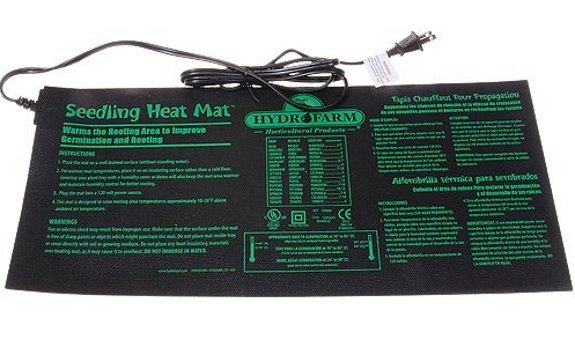
It's been a year since we
upgraded to these seedling
heat mats from Hydrofarm.
That little bit of heat seems
to make a big difference during this time of year.
I think Huckleberry likes
them even more since we let him use one during the Winter to stay extra
toasty.
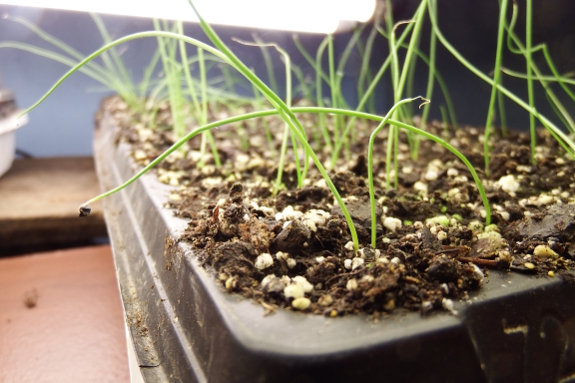
What do we have planted
in our
new seedling nook? The baby onions are up and running and I just
seeded a flat of broccoli. I filled half of another flat with peppers
then added some other slow germinators --- parsley and swiss chard ---
to round that one out. Two more weeks until I start tomatoes and basil!
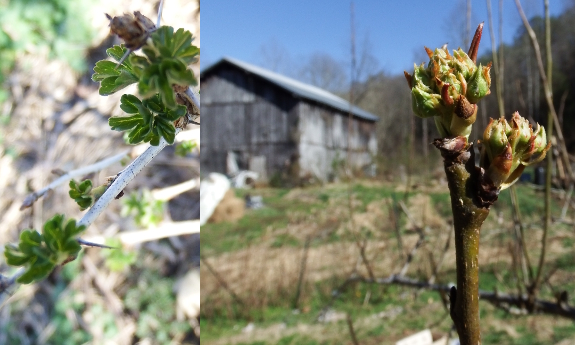
 Mom's local paper reports
that the leaves in Bristol, Tennessee, are a full month ahead of
schedule. The only leaves we have here are tiny fresh growth on
multiflora rose, autumn olive, and Japanese honeysuckle. But I can
gauge spring's advance based on the pear buds (breaking open for about
a week now) and the gooseberry leaves (which have been pushing gently
out of buds for a little longer than that).
Mom's local paper reports
that the leaves in Bristol, Tennessee, are a full month ahead of
schedule. The only leaves we have here are tiny fresh growth on
multiflora rose, autumn olive, and Japanese honeysuckle. But I can
gauge spring's advance based on the pear buds (breaking open for about
a week now) and the gooseberry leaves (which have been pushing gently
out of buds for a little longer than that).
Based on those two
metrics, I figure the beginning of March 2017 is roughly
contemporaneous with:
- March 16, 2012
- March 27, 2013
- ?March 25, 2014
- March 30, 2015
- March 17, 2016
So we're not a full
month ahead of schedule (unless you measure us by 2015), but our plants
are precocious by at least two
weeks. I guess the question becomes --- do we push our planting
calendar up an equal amount or figure there will be sudden cold spells
up to our usual frost-free date and hold the usual line?
The straw
bales we got back in the Fall turns out to have seed heads.
We might be able to use the
new flame
weeder to destroy some of the seed heads.
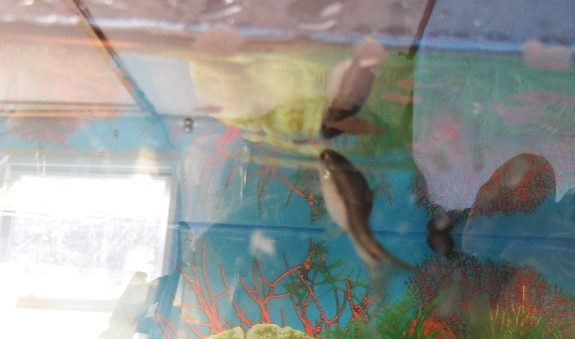
I'm afraid I can't yet
say that I've figured out how to take a passable photo through glass.
But life in the aquarium is otherwise going swimmingly.
My
two minnows and one caddisfly larva were soon joined by ten tiny
tadpoles (who they promptly ate) and seven snails (who got busy
cleaning the glass). And Friday I figured out why one of the minnows
has a tremendous belly --- that fish finally learned that flakes on the
surface are yummy and is now eating them as quickly as they appear.
Chemically, the pH is
still high (8.0), but the biological filter is obviously doing its job
well because there's barely any ammonia and no nitrite or nitrate in
the water despite daily feedings. Perhaps I should add a few more fish?
Thank you Eric and Roland for
the helpful comments on our sad truck.
Yes....I agree that it's
getting time to consider a newer truck and yes I also agree that a
replacement tank might be the best solution to fix it up for now.
It was patched a couple years
back and maybe having it towed recently damaged that patch.
I've heard good things about
the Toyota Tacoma.
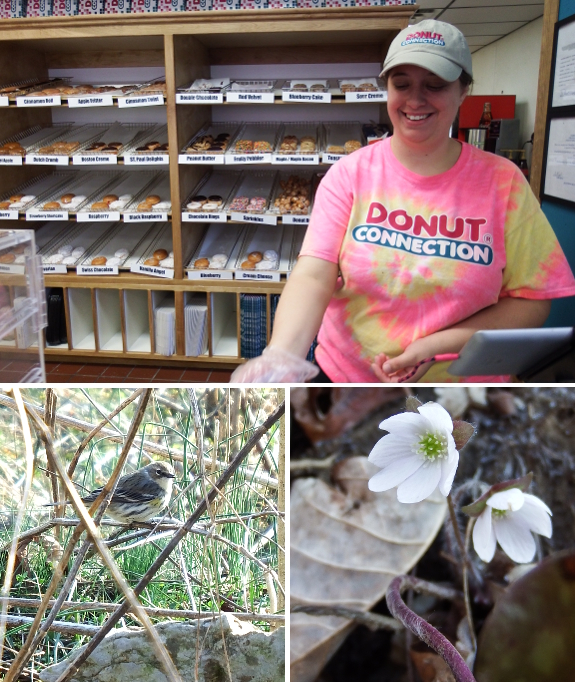
A donut shop moved into
St. Paul a few months ago and Kayla picked up a part-time gig as donut
pusher. Time to drop by and see what the fuss is about!
A chocolate donut, a
chat with a good friend, and a followup walk at Sugar Hill made for a
pretty perfect Saturday morning. The highlight of the last phase was a
full chorus of meadowlarks (not pictured) on top of the hill --- well
worth a visit for that alone!
Our garlic is doing good despite our renegade chickens destroying the mulch cover.
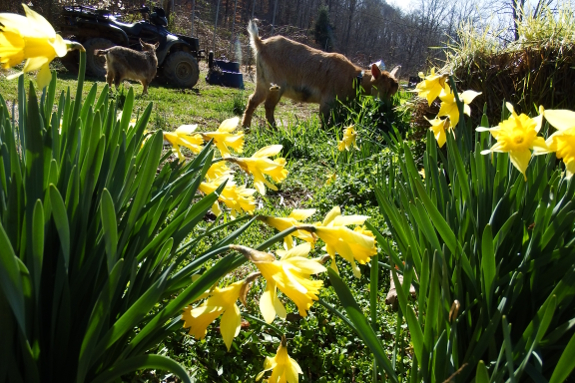
Edgar
is quickly finding his niche on our farm. He still drops his belly down
when I try to pet him...but Aurora says that's not a bug; it's a
feature. After all, she could stand for hours and let me brush her,
especially at this time of year when she's shedding her winter fluff.
Why do I need another pettable goat on the premises exactly?
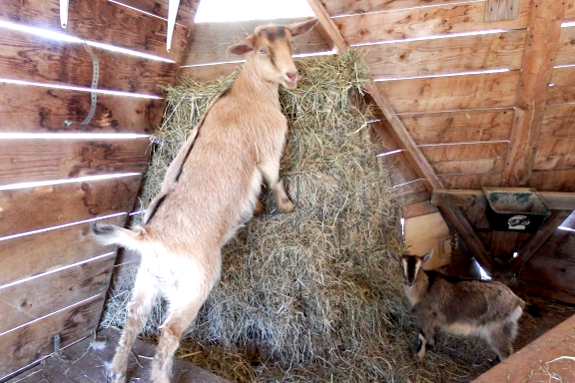
Elsewhere, our new
wether is proving to be equally adaptable. For the first week or so, I
gave him fresh hay on top of his safe spot --- the dog kennel where he
eats breakfast far from Aurora's overeager head butts. But then I
realized the imperfect hay that tends to build up in the bottom of our
manger was disappearing for the first time ever.
Sure enough, a little
sleuthing turned up what was going on. Unlike Aurora, Edgar isn't so
spoiled he considers only a tenth of the hay worth eating. That means
he's basically a net plus in the feed department since he saves me from
having to clean out the bottom of the manger. Score!
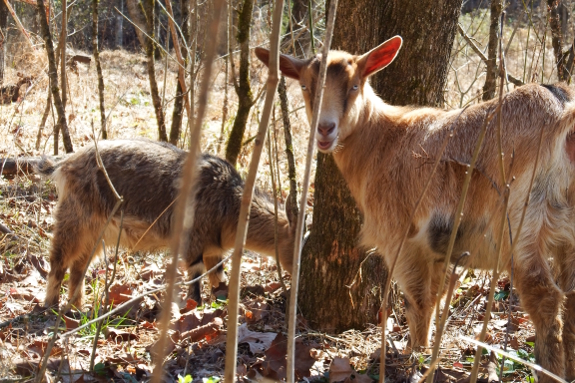
Out in the pasture,
Edgar is teaching Aurora some good habits --- like actually, you know, eating in the pasture rather than
just waiting for their daily out-of-pasture graze. On the other hand,
our new goat is a serious bark eater, so I'll have to keep a close eye
on him if I ever decide to tether him near fruit trees.
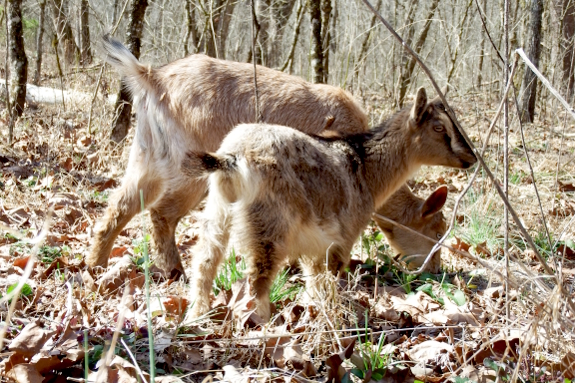
As a side note, a couple
of you have commented on his size --- pretty darn puny compared to our
doeling who is his exact same age. "Will he get any bigger?" you ask.
I'd say he will since he grew slowly with pretty much no access to
concentrates and without the extreme milk bar Aurora enjoyed. That
said, he is a pure Dwarf Nigerian rather
than sharing Aurora's 1/4 Nubian blood, so I'd expect him to always
trail behind her in bulk.
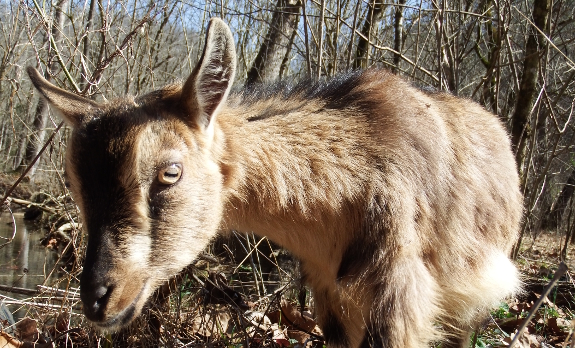
Edgar's other
interesting trait is --- he's a nibbler! Hold out your fingers and they
end up in his mouth. I guess that's better than running away when I get
close, right?
We tested the new
flame weeder out for the first time this year.
Stay tuned tomorrow to see
what kind of results show up after a day.
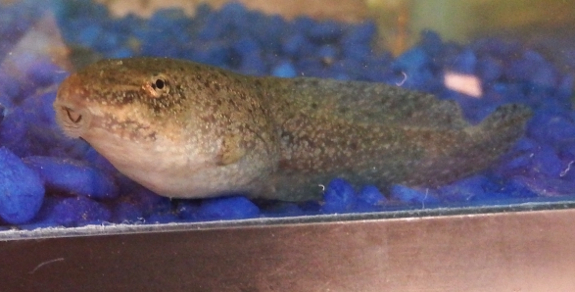
The goats and I headed
to the creek Sunday afternoon to find more life to add to my aquaponics setup. The first catch came in the
still waters of our so-called alligator swamp. (No, there are no
alligators in southwest Virginia.) Two overwintering Green Frog
tadpoles were easy to scoop up and are definitely big enough that they
won't get eaten like the baby Wood Frog tadpoles did. After all, these
tadpoles are bigger around than their neighboring fish!
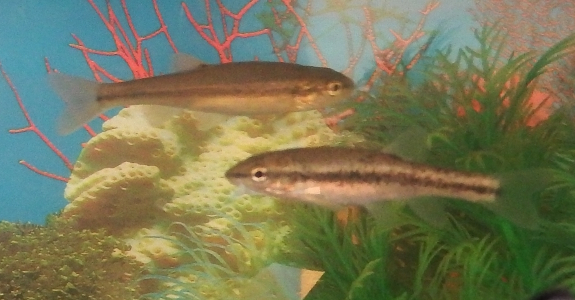
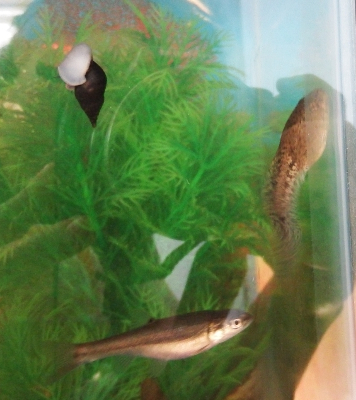 Speaking of fish,
I doubled our school with two more scooped out of the same spot in our
smaller creek. Without knowing their species, it's tough to find much
definitive information online. But if they're anything like Longnose
Dace, then I have two juveniles (with firm dark lines down their sides)
and two adults.
Speaking of fish,
I doubled our school with two more scooped out of the same spot in our
smaller creek. Without knowing their species, it's tough to find much
definitive information online. But if they're anything like Longnose
Dace, then I have two juveniles (with firm dark lines down their sides)
and two adults.
I have a feeling that Rae
might be right and the big-bellied adult is a pregnant female. If so, we'll just have to
hope the other adult is a male since dace apparently fertilize eggs
externally after they're laid. No males in sight would mean no babies.
Maybe I'll get lucky and catch the mating dance in action?
One of the thin CFL bulbs
stopped working recently on the aquaponic experiment.
I think this new shorter but
thicker CFL bulb will give more total light.
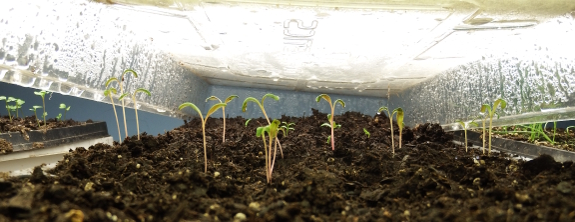
If you've got a small
garden or just a widespread wish list, it's tempting to start several
varieties of seedlings in the same flat. That can work...just as long
as you don't put fast- and slow-sprouters together.
In my slow-sprout flat
this time around, I included swiss chard, peppers, and parsley. Looks
like of those three, the last is the slowest to emerge. If I don't see
their pointy little cotyledons soon, I'll take the lid off anyway so
the first two species don't succumb to damping off. Always compromises
in the garden!
Step one on making the new
wheelchair chicken tractor is to extend the width.
I secured a 40 inch 2x4 at
the top after cutting the two metal brace poles.
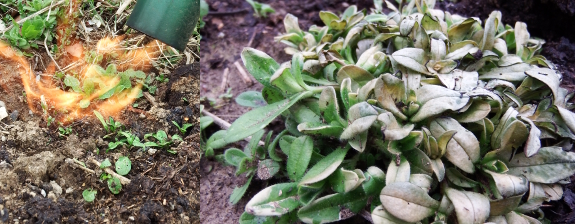
They say you can't
really tell the effects of a flame weeder until the next day, so I went
back twenty-four hours later to see how Mark's test plot
fared. This was a moderate-level request of the tool --- trying to kill
perennial weeds, but low-lying, unvigorous ones that had popped up on a
fallow bed through the course of the winter.
Did the Weed Dragon do
the trick? No. Chickweed didn't even appear singed while the other
weeds looked no worse than they might after a very hard freeze.
I'd be curious to hear
from those of you who have already experimented with these devices. Are
they really just for tender new seedlings, or have you used a flame
weeder to knock out more heavy duty weeds?
The new fuel tank also needed
the sending unit which was an unpleasant shock.
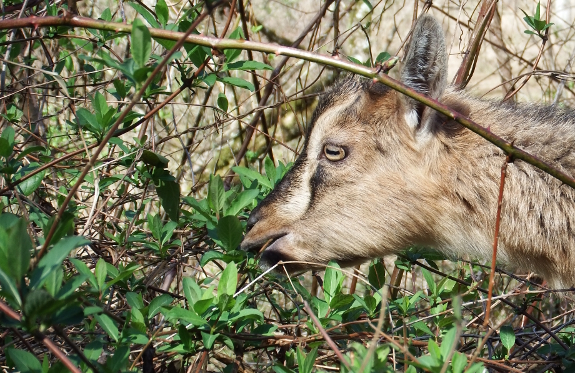
I'm ashamed to say that I didn't believe "bellwether" was referring to a neutered male animal like Edgar, so I looked it up. And, as always, Mom was right! What an interesting peek into the utility of wethers, dating back to the fourteenth century.
Extending the support brace with a smaller pipe helped to firm up the design.
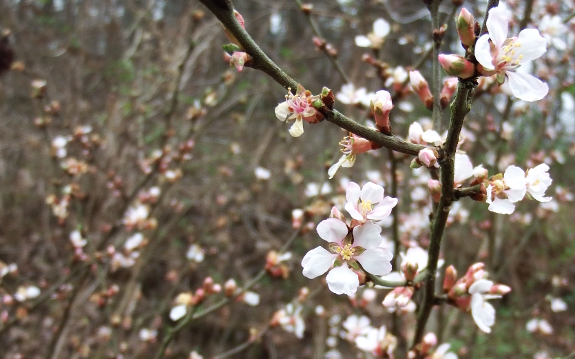
Nanking
cherries bloom on
our farm before any other fruiting plants...which is pretty but tends
to mean we don't get any fruit from the bushes.
Of course, the lack of
fruit could also be due to the location off the beaten path. Do late
freezes nip incipient fruits or do birds nibble the cherries before I
notice them? Maybe one of these days I'll be astute enough to find
out....
Now that Aurora is the Alpha
goat she's decided to let me pet her.
I'm still working on earning
Edgar's trust enough to scratch his head.
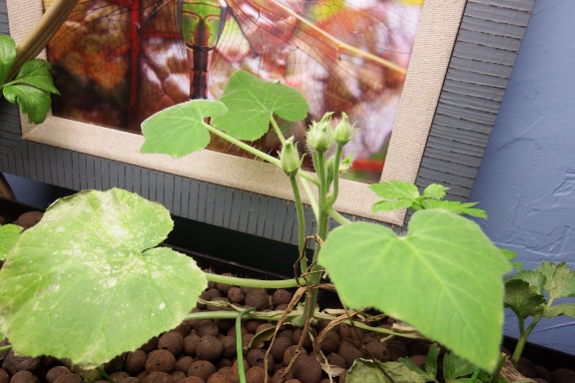
While my minnows continue to thrive and fill
me with joy, I have to admit that the plant-life in the top of the aquaponics
setup is far less
inspiring. Egyptian onions bit the dust (probably due to
overharvesting), celery is growing as slow as molasses, and my squash
plants are trying to bloom while their bush is only about eight inches
in diameter.
What's the deal? I
suspect the problem was twofold. After my first failed attempt at
adding fish...I just gave up for a few weeks. So there were basically
no nutrients in the water at all, a problem that should be correcting
itself now that I'm feeding my minnows up to half a dozen tiny pinches
per day. Around the same time, one of the lights also burnt out, which Mark
only replaced this week, so low light was likely
also a culprit.
Maybe in a week or two,
we'll finally start to see lush top growth above to match the vibrant
stream ecosystem below. I'll be sure to keep you posted either way.
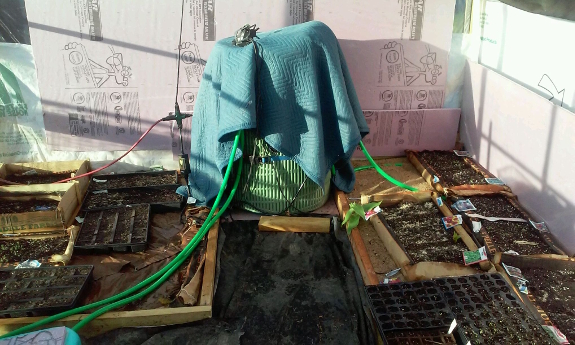
Wendy Trehus wrote in
last week to share her experiments with a hot frame created out of a
55-gallon drum combined with a water-bed heater.
She began by creating a
wooden box out of 2x6s on the ground, within which she laid a sheet of
foam insulation. Atop the insulation, she snaked a garden hose, then
backfilled the bed with sand. Both ends of the hose were left outside
the box.
Next, she filled the
55-gallon drum with water and taped the water-bed heater around it
followed by a couple of heavy blankets for insulation.
After cutting a hole in
top of the drum, she inserted a sump pump and attached it to the water
hose to circulate beneath the sand bed. A timer turns the pump on and
off every half hour.
Seed flats on top of the
sand bed enjoy bottom heat (about 65 degrees Fahrenheit). Within an
unheated cold frame in Texas, the bit of warmth is enough to get her
seedlings off to an excellent start outdoors.
Sometimes a project like the new chicken tractor goes smoother when using all three drills and the reciprocating saw.
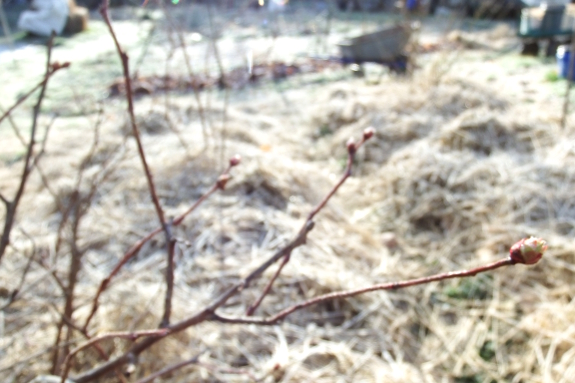
March is the month of
perennials on our farm. Pruning, weeding, topdressing, mulching --- all
fun tasks to slide into the warm afternoons that crop up at least a few
times a week.
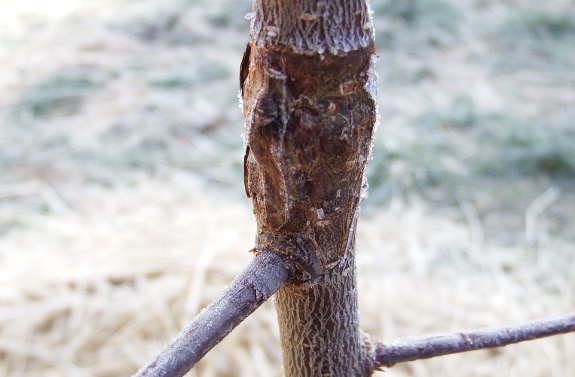
While I'm at it, I took
a look at my one perennial experiment of the year --- budded plums. I grafted two buds per
rootstock last summer, and it looks like that was just right since one
of those buds (generally the top one) seems to have glued itself into
the rootstock fairly well. I snipped the tops off the small trees to
talk them into turning those grafted buds into shoots and will wait and
see what progresses over the course of the growing season ahead.
I secured the bottom support piece by drilling holes in the wheelchair foot rest and then used treated deck screws to attach them together.
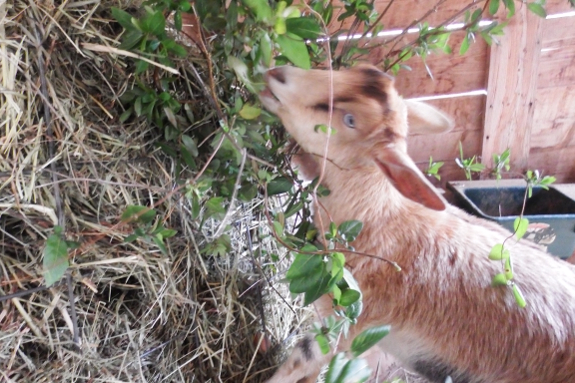
What's wrong with this
photo? I'll bet you can't guess!
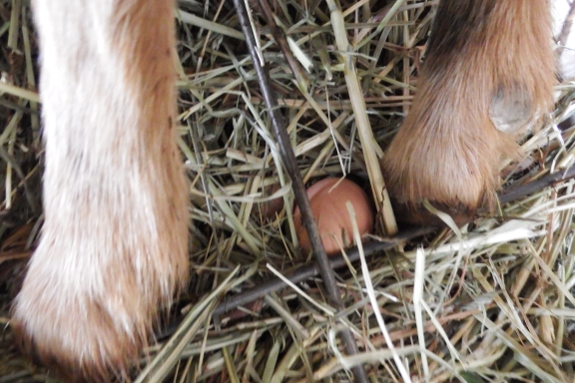
Either Edgar's started
laying eggs or our rascally chickens have taken their hidden-egg caches
to another level. Good thing Mark's building a chicken
tractor to keep our
unruly flock in its place!
Microwave frozen shitake mushrooms for 30 seconds to thaw out for cooking.
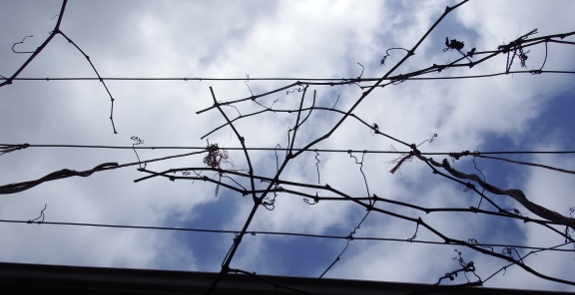
The
grapes on the trellis on the south side of the trailer are growing so vigorously
that they finally needed some serious pruning. I took the existing
tangle and snipped back vines so each 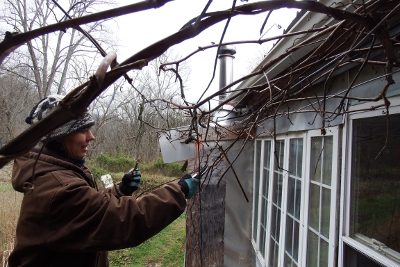 strand of wire supported a
single vine coming toward the center from each direction.
strand of wire supported a
single vine coming toward the center from each direction.
The best part of early
spring pruning is that I begin dreaming in color. Soon the winter gray
will be gone and this trellis will once again be shading our
south-facing windows while plumping up sweet grapes. Maybe in 2017
we'll get quite a few more fruits than last
year's one delicious cluster?
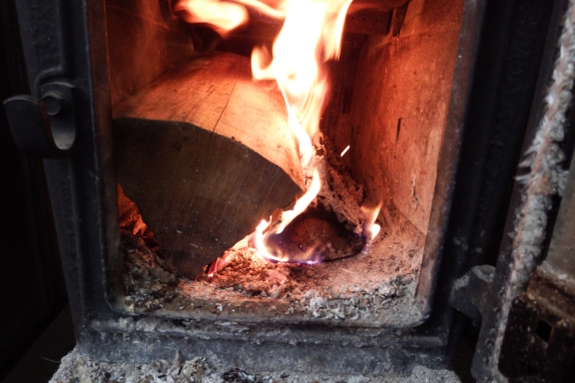
Scientists don't like
the term "global warming" because not all areas are getting hotter. And
even spots like ours where the average temperatures are rising showcase
a much more prominent change --- more climate extremes of both sorts
(highs and lows).
The smart way to react
in the garden is to resist jumping on the early-spring
bandwagon or the out-of-zone-perennial
bandwagon, no matter
how tempting they both might be. I've been dragging my heels
despite warm weather, planting at my usual times, and was very grateful
for that fact when the mercury dipped to ten degrees early Thursday
morning. I might even have to replant the spring lettuce that's just
barely germinating beneath the quick hoops --- luckily a handful of seeds is easy to scatter. Thank goodness none of our fruit trees have yet bloomed!
I attached this barbed wire a
year ago and it ended up being a mistake.
A few months ago the tension
proved to be too much and broke the top support.
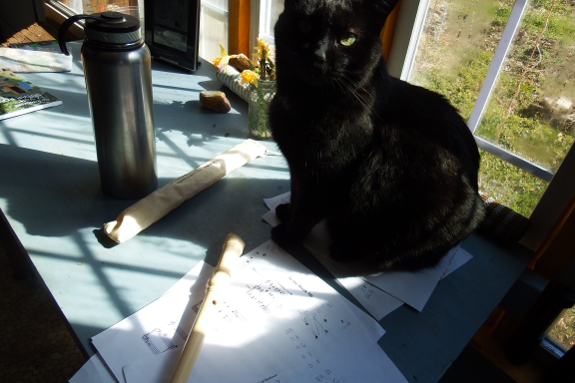
I recently picked back
up the recorder after dabbling in it briefly in fourth grade and
college. Interestingly, the experience is very different this time
around.
Sheet music lessons my
mother gave me when I was a kid suddenly click into place. (Well, some
of them.) I realize the recorder is the childhood instrument of choice
because running up from the bottom to the top is a scale starting at C
and ending at B.
And, on the negative
side, my cats remind me vocally that shrill noises aren't necessarily
pleasant on the ears. Here, Huckleberry is doing his best to cover up
my sheet music so I can't play. Strider is hiding under the trailer
waiting for the caterwauling to stop.
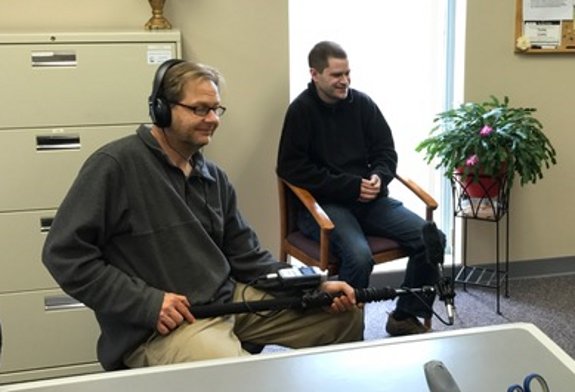
A recent film school project where I helped record sound for some interviews with Goodwill Industries in Kingsport.
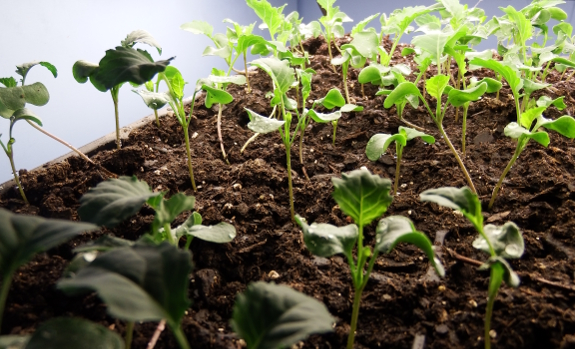
My inside seedlings took
off like a rocket after Mark
built them a special spot under the elevated sofa complete with fluorescent
lights.
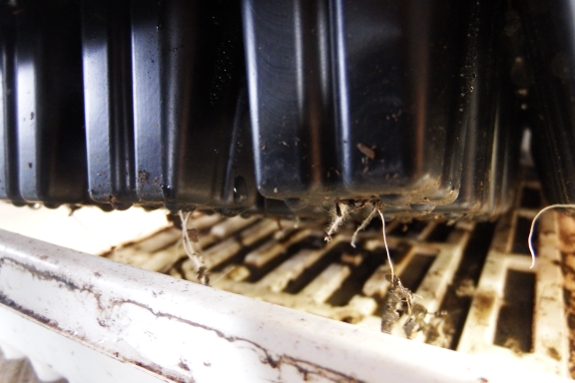
The only trouble
is...the broccoli is already growing out the bottom of the flat and
searching for real dirt! These babies aren't supposed to move to the
garden for another three weeks, but I'm already discarding
my own advice and
considering setting them out early. After all, one ten degree night
aside, it does appear to be an early spring. Right?
The willow cuttings Anna planted two years ago have more than doubled in growth since last year.
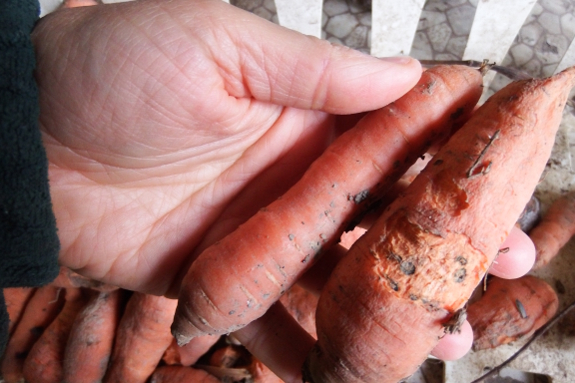
I was a lazy, lazy
homesteader this fall. Well, actually, I was too sick to do many of my
usual tasks, so I let most of them slide. But the results are the same.
I didn't mulch bare spots in the garden. I didn't put away all of the
sprinklers. And I never got around to hooking
up the backup heat
in the fridge root cellar.
The good news is, the
winter was mild and our carrots didn't rot despite (I suspect) freezing
solid a few times. The bad news is...voles got in and nibbled on the
last half bushel, turning them into goat fodder rather than human
rations.
If you're following
along at home, I'm now pretty certain that those of you in zone 7 (one
zone warmer than us) can count on a fridge root cellar doing its job
without supplemental heat. Just make sure to check your screens and
latches to keep the rodents at bay!
Sometimes the Kubota X900
shift lever gets stuck.
Turning the steering wheel
all the way to the right and then the left frees it up.
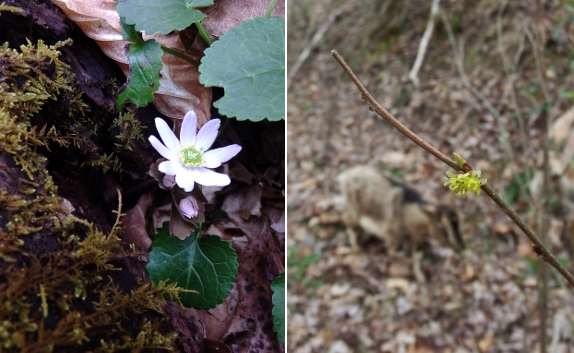
These aren't the first
flowers I saw in 2017. But they are the first flowers I saw on the
first day of spring...which makes them the first spring flowers, right?
Happy day after the
spring equinox, everybody!
The latest egg hiding spot for our renegade hen is underneath the bee hive box.
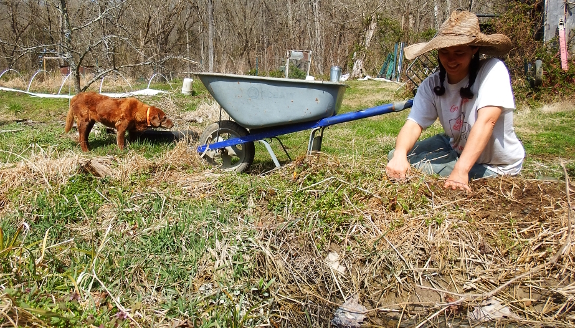
The cold snap has
passed, and now warm weather is once again tempting me out into the
garden. Good thing too because it's finally time to plant carrots and
peas.
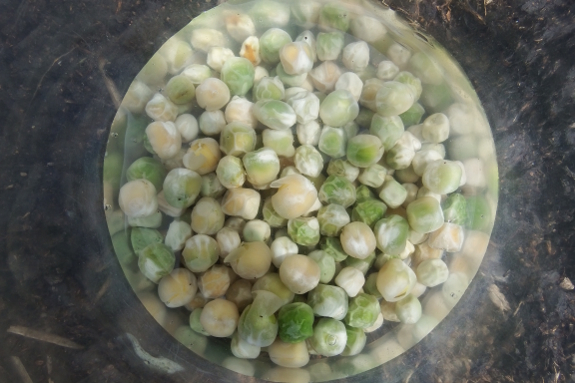
This year, I'm trying a
hybrid approach to my pea-planting. I was excited by how well inside-started
seeds did in the
garden last spring...but a bit daunted by the idea of starting several
flats of peas to hit our full quota. But what if I direct-seed the
rows, then fill in gaps with inside-started seedlings?
To that end, I filled about two-thirds of a flat with peas (the other
third going to basil and tomatoes) and soaked the rest of the packet to
go straight in the ground. Of course, you probably already see the
problem with this plan, which I only noticed as I wrote this post.
Inside-sprouted seeds will come up significantly faster and may need to
hit the garden before soil-started seeds have poked their heads above
ground. Oh well, live and learn!
The big
horse manure delivery we
got back in the Summer is still paying dividends.
We got 12 buckets today for
the Spring garden.
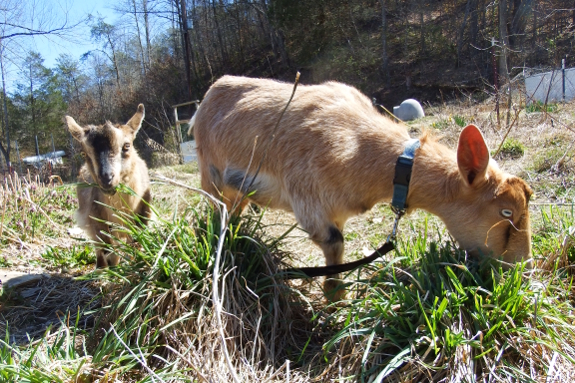
Has anyone out there
ever dealt with goat external parasites? I think Aurora must have
picked up some kind of biters, because she's been acting funny for the
last few days. She'll be grazing quite happily...then she leaps and
stomps and runs as if trying to evade a wasp. Unfortunately, there
never is a wasp, so she can't escape.
Have any of you
experienced goatkeepers dealt with anything similar? The internet
suggests that if we do have some kind of external parasite, we could
try shaving her, treating her with diatomaceous earth or various
insecticides, or just leaving her alone on the theory it'll likely go
away on its own.
Pre Beloved-goat-fading-away-to-die-a-terrible-death Anna would have
shrugged and figured Aurora would fight it off on her own, while Post
Bcfatdatd Anna is considering setting up a vet appointment for what is
likely only a minor ailment. Reality checks accepted and appreciated.
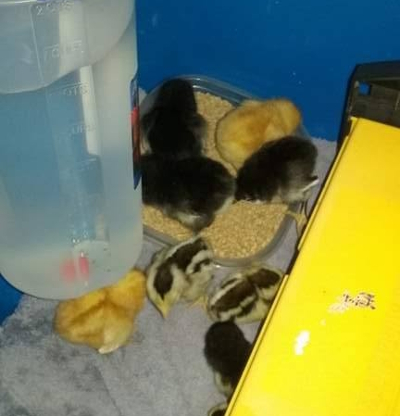 Kayla's
niece, D.D., was kind enough to foster our chicks this year.
Kayla's
niece, D.D., was kind enough to foster our chicks this year.
We set her up with the
Australorp layers we prefer along with Red Star females and a Phoenix
rooster to start her own flock.
Thanks, D.D., for taking some
of the pressure off our spring farm.
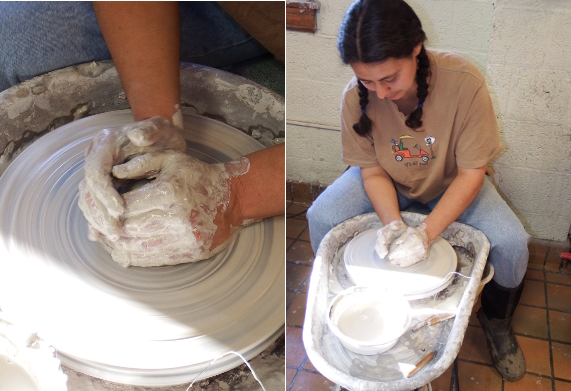
Kayla is one of the best
people I've ever met at finding free and fun activities close to home.
This time, she rustled up an adult art class funded through the 21st Century
Learning Center grant program. First installment ---
pottery!
I realized two things as
I tried to remember how to throw a pot. First --- it's been over twenty
years since I last put fingers into clay anywhere other than the
garden. Second, my teenage self had no idea how centering it is to
center a pot. I spent two hours coning and centering my clay, rarely
bothering to open a pot and never keeping a finished object. And I came
home so serene and fulfilled that I enjoyed the best night's sleep I'd
had in over a month.
Thanks so much for letting me
come, Kayla and D.D.! Now to take that lump of homework clay and turn
it into an actual object rather than a bowlful of slip.
The chicken tractor waterer will sit in the middle to distribute the weight of the water.
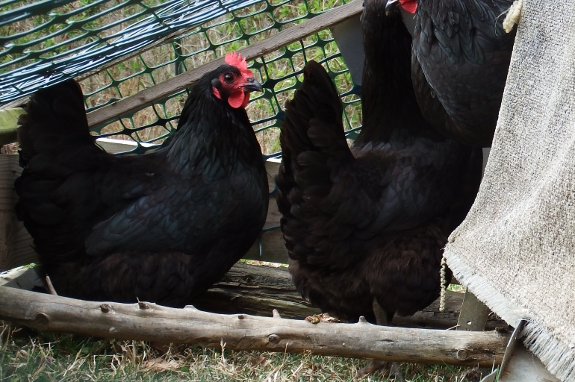
We can handle some
winter chicken scratching in the garden, but a minor nuisance becomes
potential crop loss once peas are in the ground and seedlings are
coming up. Meanwhile, it seems futile to feed hens if they're hiding
caches of eggs under
the bee hive or in the goat
manger...especially
since those infertile eggs won't hatch without a rooster around.
So I've been whittling
away the worst offenders, putting them in the old tractor where they
can't get into trouble. Three down, at least one more to go...but that
last hen is hiding her nest in the barn and I haven't found it yet.
Maybe this weekend I'll manage to track her clucking back to its source?
It's been almost a year since
I first used Flex
Seal to make this lid stop leaking.
The fix is holding up good
and looks like it will last as long as the lid.
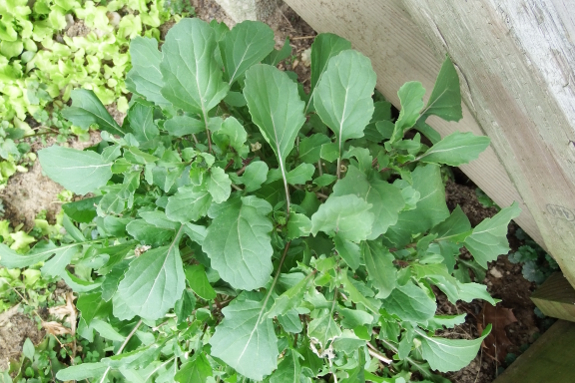
I'll admit that I'm
unimpressed by the lettuce this spring in the cold
frame. I suspect the issue is temperature extremes (too hot when I
forget to open the glass, too cold when I forget to close the glass)
combined with moisture extremes (too dry most of the time, then swamped
when water gushes off the roof and onto the baby plants). The
over-wintering arugula, on the other hand, is going gangbusters.
Actually I planted this
arugula's parents in October 2015. The plants grew, went to seed last
spring, then self-sowed replacement rosettes. I picked leaves off and
on all winter and am now harvesting the rapini heavily to fill spring
omelets. At some point, I'll let the poor plants go to seed and repeat
the cycle...but I'm enjoying the meals too much to let them go quite
yet. Instead, I'm just enjoying seemingly endless arugula, all from one
small packet of seeds sprinkled on the ground eighteen months ago.
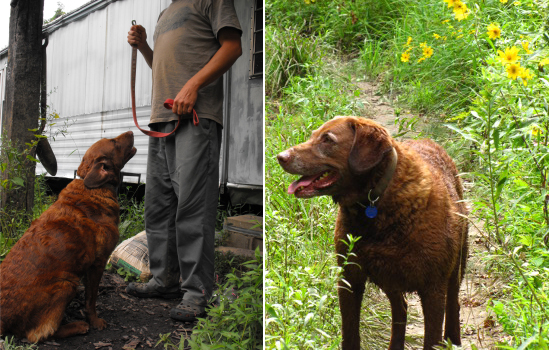
Lucy died Saturday night
at the ripe old age of twelve and a half. She was the kind of dog who
turned cat people into dog people, but that's only the tip of the
iceberg. She was...
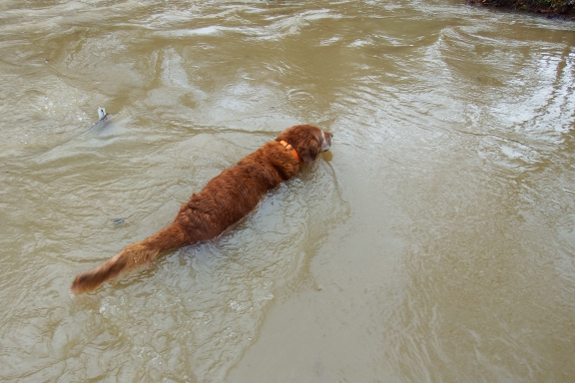
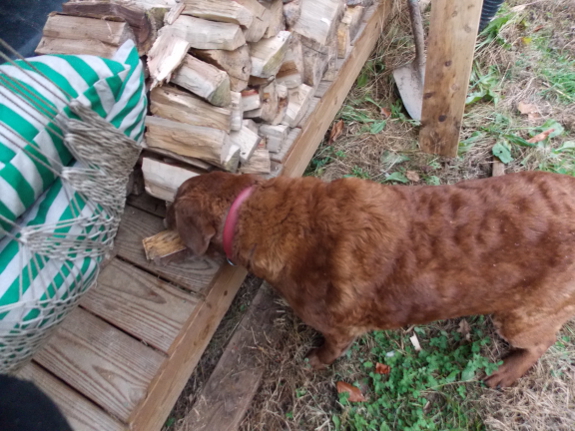
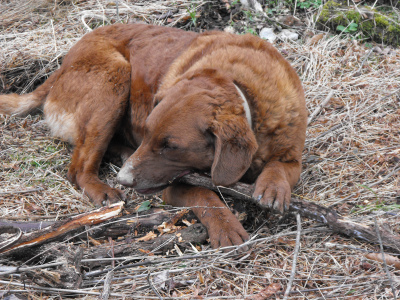
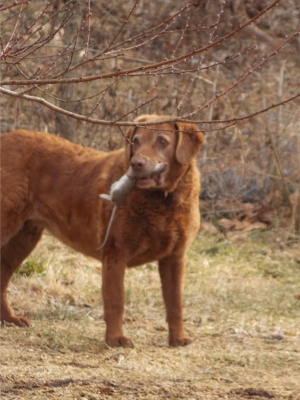
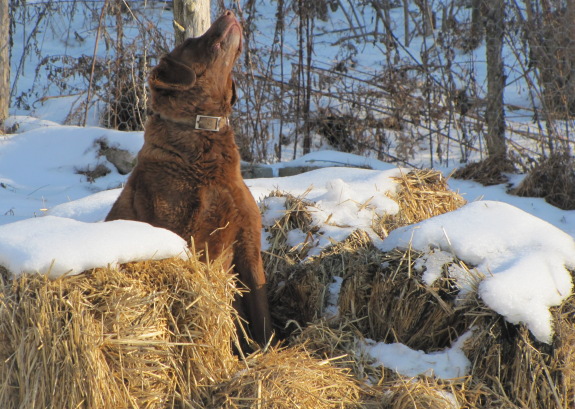
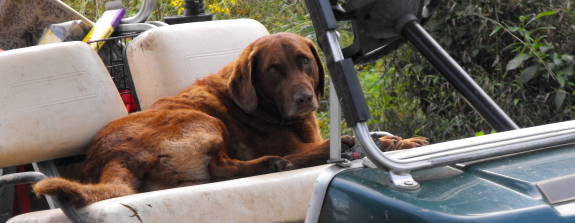
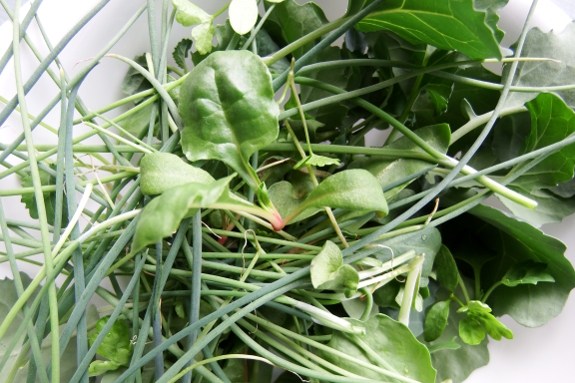
Start with a bowl of
thinnings from your vegetable flats. Many (but not all!) vegetables are
edible at the seedling stage. In general, figure if you eat the leaves
or stems of the adult plant, then the seedlings are probably good to
eat as well. Here, I thinned onions, broccoli, parsley, and Swiss chard
to add to our salad.
Mix seedlings with an
equal quantity of spring lettuce, a couple of slices of cooked bacon
(crumbled), and a few roasted figs (sliced into small pieces). Top with
your favorite salad dressing if you prefer, then enjoy. Early spring
flavors at their best!
Anna and I want to thank
everybody for their kind words and thoughts.
We've decided to take the
week off blogging to reflect and recharge.
We'll start back up on
Saturday or Sunday.
Thanks again for being there
for us.
Want more in-depth information? Browse through our books.
Or explore more posts by date or by subject.
About us: Anna Hess and Mark Hamilton spent over a decade living self-sufficiently in the mountains of Virginia before moving north to start over from scratch in the foothills of Ohio. They've experimented with permaculture, no-till gardening, trailersteading, home-based microbusinesses and much more, writing about their adventures in both blogs and books.
